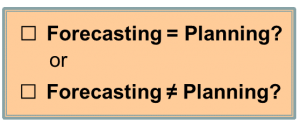
Most every organization goes through an annual planning process. Many families do the same although normally not as rigorous. Both personal and workplace planning usually includes a financial component. Forecasts are made for income. Estimates are made for expenses and purchases. Budgets are set. Investments are reviewed and planned for.
What happens beyond financial planning varies widely from organization to organization. There are at least five different planning philosophies organizations use:
1) At one extreme are organizations who only allocate time to financial forecasting and give little attention to how they will achieve their forecast. They allocate virtually no time to assessing their organization or reviewing their strategy. They consider planning to be the same as forecasting.
2) At the other extreme are organizations who analyze everything. They do what-if analysis, risk assessments, and contingency planning. They acquire external data. They review internal data. They use the latest management tools to perform analyses that when done produce a significant amount of information to be reviewed and discussed. They have deep organizational awareness and derive insights that others have no clue about. They consider planning significantly more than forecasting. But in some cases, the result is the proverbial tome that sits on the shelf to collect dust.
3) There are organizations that see business planning as the creation of a deliverable rather than a process. They see planning as a check-in-the-box exercise. Some even equate their business plan with a marketing document like a glossy brochure. As if in a beauty contest, their main priority is creating something pretty to look at. These plans tend to be so general that they provide little direction. They tend to ignore reality. They are overly optimistic as if they are selling something.
4) There are organizations who place agility so high on their list of priorities that they shun all but the most basic of planning. They create plans with the expectation that they won’t be relevant for very long. They plan to react to change when it comes rather than drive change. They only commit to what is absolutely necessary so they retain the flexibility to go in whatever direction needed.
5) Top performing organizations typically see planning as a process more than a deliverable. They use planning as an opportunity to get off the treadmill of busyness as usual and work on the business instead of just working in the business. They do much more than financial forecasting but not so much that they waste valuable resource. They create business plans that are more strategic than financial forecasts but more practical than exhaustive plans with hundreds of pages of data. Their planning process assesses internal and external forces on their organization. They identify and address stubborn obstacles impacting the performance of their organization. They explore new opportunities, approaches, markets, and offerings. They evaluate and debate alternatives. They agree on strategies, goals, initiatives, and plans that guide their organizations toward achieving both tactical and strategic goals.
If you have influence over your organization’s approach to business planning, listed below are elements to which you might allocate attention. Particularly if you are an organization that treats planning as a financial exercise or a pretty document, consider which of the areas below might be worth attention beyond the first bullet—finances:
- Finances – historical, current, forecasts, incomes, expenses, investments, returns, budgets, inventories, assets, liabilities, ratios
- Employees – engagement, wellness, retention, acquisition, competencies, performance, development, compensation, recognition, succession, policies
- Customers and markets – tiers, market shares, satisfaction levels, relationship levels, trends, opportunities and needs, threats
- Partners and suppliers – supply chain analysis, issues and needs, partner responsibilities and contributions, supplier performance
- Competitors – industry benchmarks, target markets, offerings, reviews, pricing, strengths, vulnerabilities, investments and plans
- Portfolio – products, services, financial performance, market shares, features and differentiators, value propositions, pricing, revisions and upgrades, roadmaps
- Social, economic, and government influences – social norms and changes, economic impacts, government funding and policy shifts
- Organizational functions – performance, structure, key contributions, process efficiencies, assets, facilities, issues and risks, needs
- Technologies and trends – IT systems and tools, networking, security, data, automation, revenue opportunities, online presence, emerging technologies
- Strategies and goals – vision, values, internal and external priorities, growth plan, offerings, target markets, routes to market
- Social, community, environmental responsibility – guiding philosophies, programs, sponsorships, events, grants, funding, volunteer participation
- Initiatives and plans – key programs and projects, internal and external, departmental and cross-functional, with milestones, timelines, and action plans
- Ongoing tracking and communication – key performance indicators, business review schedule, recurring meetings and reports
Article by Mike Hawkins, award-winning author of Activating Your Ambition: A Guide to Coaching the Best Out of Yourself and Others (www.ActivatingYourAmbition.com), author of the SCOPE of Leadership six-book series on coaching leaders to lead as coaches (www.ScopeOfLeadership.com), and president of Alpine Link Corp (www.AlpineLink.com), a boutique consulting firm specializing in leadership development and sales performance improvement. For other articles on reaching your peak potential, visit: www.alpinelink.com/blog
